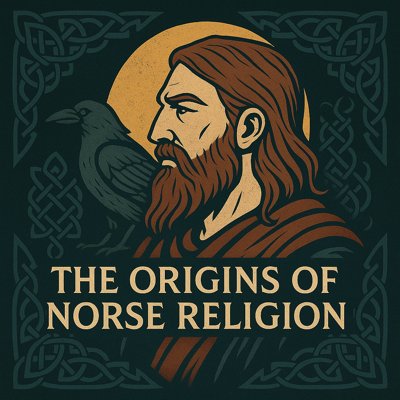

Before the thunder of Thor’s hammer and the wisdom of Odin’s ravens became cultural icons, the Norse religion had already traveled a long path of evolution. The belief system that reached its most vivid expression during the Viking Age (c. 750–1050 CE) was not created in isolation but grew from a deep well of Proto-Germanic and Indo-European traditions.
This article explores the origins of Norse religion: its roots, its development in pre-Christian Scandinavia, and the cultural and social factors that shaped its worldview. Along the way, we will also consider how myths of Odin, Thor, Freyja, Loki, and Baldr reflect not only poetic imagination but also ancient concerns about fate, warfare, fertility, and survival.
⚡ Channel Thor’s Strength — Thor Hoodie
👕 Thor Long Sleeve Available Here
Norse mythology belongs to the larger family of Indo-European religions, which also gave rise to Greek, Roman, Celtic, and Hindu traditions (Mallory & Adams, 2006). Comparative mythology shows striking parallels:
The Norse sky father Odin resembles the Vedic Dyaus Pitar or Roman Jupiter.
The Norse thunder god Thor parallels the Vedic Indra and the Slavic Perun.
The tripartite structure of society (priests, warriors, farmers) appears both in Indo-European culture and in the Norse division between the Aesir, Vanir, and humans.
The Proto-Indo-European religion emphasized the sacredness of oaths, the central role of fate, and the cosmic struggle between order and chaos. These themes carried into Germanic and then Norse belief.
By the early centuries CE, the Proto-Indo-European inheritance had transformed into Germanic paganism, practiced across northern Europe. Tacitus, a Roman historian writing around 98 CE, described Germanic tribes worshipping gods he identified with Mercury (likely Odin), Mars (Tyr), and Hercules (Thor) (Germania, 9).
Rituals often took place in groves, lakes, or bogs, with sacrifices offered to deities and spirits. Archaeology supports this picture: weapon offerings in Danish bogs (c. 1st–4th centuries CE) suggest ritual dedications after battle victories (Price, 2020).
🦅 Embody Odin’s Wisdom — Odin Hoodie
👕 Odin T-shirt coming soon — full set upgrade awaits!
One of the distinctive features of Norse mythology is its dual pantheon: the Aesir (warrior gods like Odin, Thor, and Tyr) and the Vanir (fertility gods like Freyr and Freyja). Scholars believe this reflects the fusion of two different religious traditions, possibly mirroring cultural contact between early Indo-European settlers and indigenous farming populations in Scandinavia (Simek, 2007).
The Aesir embodied sovereignty, law, and war.
The Vanir represented fertility, prosperity, and nature.
The myth of the Aesir–Vanir War may symbolize the merging of these traditions into a unified Norse cosmology.
✨ Honor Freya’s Power — Freya Hoodie
🌸 Freya Tee Available Here
At the heart of Norse religion lay Yggdrasil, the world tree connecting the nine realms. This cosmology reflects both Indo-European mythic archetypes and uniquely Norse ideas of interconnectedness. The concept of fate (wyrd or urðr) was central: not even the gods could escape destiny.
The gods themselves were mortal in the sense that they would perish at Ragnarök. This tragic worldview set Norse paganism apart from many other religions, highlighting the inevitability of death and the value of courage in the face of doom (Lindow, 2001).
Norse religion was not only mythology but also ritual practice:
Blót (sacrifice): Offerings of animals, food, and occasionally humans were made to secure fertility, victory, or protection.
Seiðr (magic): A shamanic form of sorcery associated with Odin and Freyja, involving prophecy and fate manipulation.
Festivals: Seasonal rituals marked solstices, harvests, and battles.
🔥 Loki gear coming soon — stay tuned, trickster fans!
Archaeology offers crucial insights into Norse religion’s origins:
Bog offerings in Denmark and Sweden show ritual deposition of weapons and treasures.
Burial mounds (like those at Uppsala) suggest belief in an afterlife where social status continued.
Runestones often invoked Thor for protection, showing his importance in daily life.
🌟 Baldr collection in development — purity meets power!
By the Viking Age (c. 750–1050 CE), Norse religion had crystallized into the forms we recognize from the Eddas:
Odin as the Allfather, seeker of wisdom.
Thor as the protector of gods and men.
Freyja as both goddess of fertility and chooser of the slain.
Loki as trickster and catalyst of chaos.
Baldr as the radiant god whose death heralded Ragnarök.
These figures embodied the core values of a warrior society facing both prosperity and peril at the edge of the known world.
The Norse religion, born from Proto-Indo-European roots and shaped by centuries of cultural exchange, left a profound mark on northern Europe. Even after the Christianization of Scandinavia, echoes of its myths persisted in folklore, place names, and cultural memory.
Today, the origins of Norse religion are not just a matter of academic study but a source of inspiration. In fitness, fashion, and popular culture, gods like Odin, Thor, and Freyja continue to symbolize strength, wisdom, and resilience — values that remain timeless.
The origins of Norse religion can be traced from Indo-European myth, through Germanic paganism, into the distinctive mythology of the Viking Age. Its worldview combined fate and freedom, tragedy and heroism, war and fertility. By examining these origins, we see how a religion born in ancient groves and battlefields came to inspire sagas, poems, and even modern apparel.
The Norse religion was not merely about gods and myths — it was about how human beings confronted the inevitability of fate with courage, ritual, and story.
Larrington, Carolyne. The Poetic Edda. Oxford University Press, 2014.
Faulkes, Anthony. Edda. Everyman, 1995.
Simek, Rudolf. Dictionary of Northern Mythology. Boydell & Brewer, 2007.
Lindow, John. Norse Mythology: A Guide to the Gods, Heroes, Rituals, and Beliefs. Oxford University Press, 2001.
Price, Neil. Children of Ash and Elm: A History of the Vikings. Allen Lane, 2020.
Mallory, J.P. & Adams, D.Q. The Oxford Introduction to Proto-Indo-European and the Proto-Indo-European World. Oxford University Press, 2006.